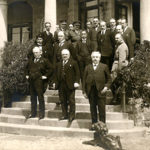Published October 20, 2010
Conference on "Economics at the Crossroads," Tocqueville Forum and Society of Catholic Social Scientists at Georgetown University
[Editor’s note: The following remarks were delivered at the Conference on “Economics at the Crossroads” for The Tocqueville Forum and the Society of Catholic Social Scientists at Georgetown University, October 20, 2010. The remarks are based on Mr. Mueller’s new book, Redeeming Economics: Rediscovering the Missing Element.]
I’m grateful to my old friends at the Tocqueville Forum and the Society of Catholic Social Scientists, Patrick Deneen and Steven Brust, and pleased to join John Médaille and Barry Lynn for this discussion of “Economics at the Crossroads.” Though also disconcerted to find myself on this side of the podium. I’ve attended the Tocqueville Forum so often that Tara Jackson said she was surprised I had never submitted an IRS W-9 form. Yet, as Walker Percy warned in Lost in the Cosmos, “a charade was being played” with “William Faulkner, doing a morning’s work, then strolling in the town square to talk to the farmers and have a Coke at Reed’s drugstore…. Though Faulkner went to great lengths to pass himself off as a farmer among farmers, farmer he was not.” Or take “Søren Kierkegaard, who, every hour, would jump up from his desk, rush out into the streets of Copenhagen, and pass the time with shopkeepers. . . ..[B]y his own admission, he was playing the game of being taken for an idler at the very time he was writing ten books a year.” Now I too must admit, every month, by jumping up from my desk, rushing out into the streets of Washington, and passing the time at the Tocqueville Forum, to have been playing the game of being taken for an idler, at the very time I was churning out a book every ten years!
The thesis of my book is straightforward: The most important element in economics is missing, and its rediscovery is priming a revolution the likes of which has occurred just three times in more than 750 years.
I must begin with a simple but widely overlooked fact: the logical and mathematical structures of scholastic, classical and neoclassical economics differ fundamentally. Yet few economists today are aware of the differences because American university economics departments, led by the University of Chicago in 1972, abolished the previous requirement that students of economics master its history before being granted a degree. This calls for a brief, structural history of economics.
What is economics about? Jesus once noted — I interpret this as an astute empirical observation, not divine revelation — since the days of Noah and Lot, people have been doing, and until the end of the world presumably will be doing, four kinds of things. He gave these examples: “planting and building,” “buying and selling,” ‘marrying and being given in marriage,” and “eating and drinking” (Luke 18:27-28). In other words, we produce, exchange, give, and use (or consume) our human and nonhuman goods.
That’s the usual order in our action. But as St. Augustine first explained, the order is different in our planning. First we choose For Whom we intend to provide; next What to provide as means for those persons. Finally, Thomas Aquinas latter added, we choose How to provide the chosen means, through production (always) and exchange (almost always), both of which Aristotle had described.
So, economics is essentially a theory of providence: it describes how we provide for ourselves and the other persons we love, using scarce means that have alternate uses. Human providence is a synonym for the cardinal virtue of prudence. Aristotle had divided moral philosophy into ethics and politics. But he also aptly described humans as “rational,” “matrimonial,” and “political animals.” So Aquinas redivided moral philosophy into three, distinguishing personal, domestic, and political prudence — or equivalently, “economy” — according to the social unit described.

Scholastic ‘AAA’ economics (c.1250-1776) began when Aquinas first integrated these four elements (production, exchange, distribution, and consumption) into an outline of personal, domestic, and political economy, both positive and normative, organizing Aristotle’s contributions according to Augustine’s framework. The scholastic economic theory was taught at the highest university level for more than five centuries by every major Catholic and (after the Reformation) Protestant economic thinker before Adam Smith — notably Lutheran Samuel Pufendorf, whose work was used by Adam Smith’s own teacher to teach Smith economics, and also highly recommended by Alexander Hamilton.
Classical economics (1776-1871) began when Adam Smith cut these four elements to two, trying to explain what he called “division of labor” (specialized production) by production and exchange alone. Smith was addressing the main drawback of scholastic economics, which lay not in the theory itself, but the routine assumption that the economy did not grow in the long run — which had been true on average for about two millennia. To explain growth, Smith and classical followers like David Ricardo undoubtedly advanced the two elements Smith retained. But it was on oversimplification.
Neoclassical economics (1871-c.2000) began when three economists dissatisfied with the practical failure of Smith’s classical outline independently but almost simultaneously reinvented Augustine’s theory of utility, starting its reintegration with the theories of production and exchange.
Thus Adam Smith’s chief significance is not what he added to, but rather subtracted from economics. As Joseph Schumpeter noted in his History of Economic Analysis, “The fact is that the Wealth of Nations does not contain a single analytic idea, principle or method that was entirely new in 1776.”
Neoscholastic economics (c.2000-). I argue that Neoscholastic economics is already and will continue to revolutionize economics in coming decades, by replacing its lost cornerstone, the theory of distribution.

This historical analysis offers a framework for analyzing other schools of economics. But I will not pursue these lesser differences unless someone asks.
Since Smith essentially “de-Augustinized” economic theory, a re-evaluation is overdue and quite likely for Adam Smith but especially Augustine. So I’ll consider Augustine’s contribution to both scholastic and today’s neoclassical economics, then give an example of the problems in today’s neoclassical economics caused by the failure to restore them, and close with a word about the world views implicit in each theory.
A. Positive scholastic theory. To explain the Two Great Commandments, Augustine had started from Aristotle’s insight that “every agent acts for an end” and his definition of love — willing some good to some person. But Augustine drew an implication that Aristotle had not: every person always acts for the sake of some person(s). For example, when I say, “I love vanilla ice cream,” I really mean that I love myself and use (consume) vanilla ice cream to express that love (in preference, say, to strawberry ice cream or Brussels sprouts, which reflects my separate scale of utility). Augustine also introduced the important distinction between “private” goods like bread, which inherently only one person at a time can consume, and “public” goods (like a theater performance, national defense, or enforcement of justice) which, at least within certain limits, many people can simultaneously enjoy, because they are not “diminished by being
shared.” 
In other words, Augustine’s crucial insight is that we humans always act on two scales of preference — one for persons as ends and the other for other things as means: personal love and utility, respectively. Moreover, we express our preferences for persons with two kinds of external acts. Since man is a social creature, Augustine noted, “human society is knit together by transactions of giving and receiving.” But these outwardly similar transactions may be of two essentially different kinds, he added: “sale or gift.” Generally speaking, we give our wealth without compensation to people we particularly love, and sell it to people we don’t, in order to provide for those we do love. Since it’s always possible to avoid depriving others of their own goods, this is the bare minimum of love expressed as benevolence or goodwill and the measure of what Aristotle called justice in exchange. But our positive self-love is expressed by the utility of the goods we provide ourselves, and our positive love of others with beneficence: gifts. Hate or malevolence is expressed by the opposite of a gift: maleficence or crime.
The social analog to personal gifts is what Aristotle called distributive justice, which amounts to a collective gift: it’s the formula social communities like a family or nation under a single government necessarily use to distribute their common (jointly owned) goods. Both a personal gift and distributive justice are a kind of “transfer payment”; both are determined by the geometric proportion that matches distributive shares with the relative significance of persons sharing in the distribution; and both are practically limited by the fact of scarcity.
That’s “positive” scholastic economics in a nutshell: describing what is, not necessarily what ought to be.
B. Normative” scholastic theory. We naturally love ourselves, Augustine pointed out. All other moral rules are derived from the Two Great Commandments because these measure the degree to which our love is “ordinate”: rightly ordered. If a good were sufficiently abundant we could and should share it equally with everyone else. But with such goods as time and money, which are “diminished by being shared” (i.e., scarce), this is impossible. Therefore “loving your neighbor as yourself” can’t always mean equally with yourself: “All men are to be loved equally. But since you cannot do good to all,” Augustine concluded, “you are to pay special regard to those who, by the accidents of time, place, or circumstances, are brought into closer connection with you.”
The (neo-) scholastic model is a powerful tool of analysis. In the book I suggest several important applications, which I’m willing to discuss at the drop of a question. In view of our severe time limits, though, I will focus here on one simple and striking example: the inverse tradeoff between fatherhood and crime.
In a famous paper co-authored with John J. Donohue and later featured in his book (and now movie) Freakonomics, Steven D. Levitt argued that after abortion was legalized by several states starting in the late 1960s and nationwide by Roe v. Wade in 1973, millions of fetuses were killed who, when old enough, would have been disproportionately likely to commit crimes. Abortion’s culling of them should therefore have lowered crime rates. To prove this, Levitt and Donohue looked at crime rates 15-18 years after Roe and claimed to have found the drop they had predicted.
However, Levitt and Donohue actually found their results indistinguishable whether they used 1970s or 1990s abortion rates to try to explain overall ’90s crime rates. When both were included the models went statistically haywire (“standard errors explode due to multicollinearity”). Failing to uncover any statistically valid evidence for either a 20-year lag or for no lag, Levitt and Donohue replaced the missing facts with an arbitrary assumption: “Consequently, it must be recognized that our interpretation of the results relies on the assumption that there will be a fifteen-to-twenty year lag before abortion materially affects crime.” 
They justified their assumption by quipping that “infants commit little crime.” But nearly all violent crime is committed by men (women are equal only in nonviolent crime) precisely the ages of the fathers of aborted children. In short, the missing variable is “economic fatherhood.” (“Economic” fatherhood is defined not by biological paternity nor residency with but provision for one’s children.) The relationship between economic fatherhood and crime is a straightforward application of Augustine’s personal “distribution function” to the most valuable scarce resource of mortal humans: our time.

Including “economic fatherhood” as a variable not only invalidates Levitt’s claim but reverses it. As far back as data exist, rates of economic fatherhood and homicide have been strongly, inversely “cointegrated” — a stringent statistical test characterizing inherently related events, like the number of cars entering and leaving the Lincoln Tunnel. Donohue and Levitt’s correlation is thus shown to be a “spurious regression,” which was misspecified by omitting a crucial variable: the one describing Augustine’s personal “distribution function.” Legalizing abortion didn’t lower homicide rates 15-20 years later by eliminating infants who might, if they survived, have become murderers: it raised the homicide rate almost at once by turning their fathers back into men without dependent children-a small but steady share of whom do murder. The homicide rate rose sharply in the 1960s and ’70s when expanding welfare and legal abortion sharply reduced economic fatherhood, and it dropped sharply in the ’90s partly due to a recovering birth rate, but mostly because welfare reform and incarceration raised the share of men outside prison who were supporting children. [This scenario didn’t occur to Levitt not because of a lack of ingenuity or data but because of the inherent weakness of the theory he was trying to apply, which Nobel Prize-winning economists George J. Stigler and Gary S. Becker, Levitt’s mentor, called the “economic approach to human behavior.” Levitt was unable to see the true correlation between abortion and crime because he was among the first victims of the epic change in the teaching of economics orchestrated by Stigler with Becker’s support].
The choice of 1776. What I call “Smythology” (with two y’s) is the myth that Adam Smith invented or is somehow indispensable to understanding economics. By far the most influential piece of “Smythology” was Milton Friedman’s linking in Free to Choose of “two sets of ideas — both, by a curious coincidence published in the same year, 1776…. the economic principles of Adam Smith…and the political principles expressed by Thomas Jefferson.”Like many others, I found Friedman’s argument persuasive and incorporated it into my own views, until I discovered that the “choice of 1776” was actually a divergence, not a convergence, and of three, not two world views. The third event of 1776 was the death of Smith’s dear friend, the Epicurean skeptic David Hume.
When the Apostle Paul preached in the marketplace of Athens (probably in 51 A.D.), he prefaced the Gospel with a Biblically orthodox adaptation of Greco-Roman natural law. The evangelist Luke tells us that “some Epicurean and Stoic philosophers argued with him” (Acts 17:18). The same dispute has continued ever since, particularly among scholastic, classical, neoclassical, and now neoscholastic e
conomists.
In (neo-) scholastic natural law, economics is a theory of rational providence, describing how we choose both persons as “ends” (expressed by our personal and collective gifts) and the scarce means used (consumed) by or for those persons, which we make real through production and exchange. By dropping both distribution and consumption, Smith expressed the Stoic pantheism that viewed the universe “to be itself a Divinity, an Animal” (as he put it in an early but posthumously published essay), with God conceived as its immanent soul, so that sentimental humans choose neither ends nor means rationally; instead, “every individual…intends only his own gain…and is led by an invisible hand to promote an end which was no part of his intention.” By restoring consumption but not distribution, neoclassical economics expresses the Epicurean materialism that claims humans somehow evolved in an uncreated world as merely clever animals — highly adept at calculating means but not ends, since “reason is, and ought only to be, the slave of the passions,” as Hume put it. The three theories provide three views of both human and divine nature, but only the anthropology and theology of the scholastic theory are compatible with Christian orthodoxy.
As historian of economics Henry William Spiegel noted of the “marginal revolution” that ended classical and launched neoclassical economics in the 1870s, “Outsiders ranked prominently among the pioneers of marginal analysis because its discovery required a perspective that the experts did not necessarily possess.” I don’t underestimate the time or effort it will take. But I confidently predict that in coming decades, neoclassical economists now advocating the “economic approach to human behavior” will either become or else be supplanted by “neoscholastic” economists — who will find full employment rewriting neoclassical theory because they understand the original “human approach to economic behavior” of Aristotle, Augustine, and Aquinas.
John Mueller is a fellow at the Ethics and Public Policy Center in Washington, D.C.












